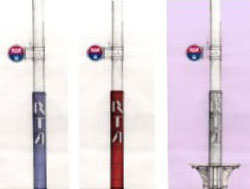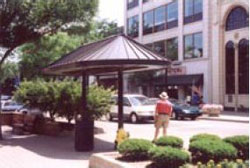Transit Waiting Environments
Cleveland, Ohio
Source: Pedestrian and Bicycle Information Center (PBIC)

A sketch of the different transit signs for RTA.
Background
There are 8,492 bus stops in the Greater Cleveland Regional Transit Authority (GCRTA) system, but less than 20 percent of them have a shelter and many of the rest are equipped with little more than a transit sign fixed to a convenient utility pole. The transit authority solicited suggestions from the Citizen Advisory Board in an effort to increase transit ridership. As quoted in their final report, the Transportation Research Board concluded that, "The quality of the customer experience while waiting for transit vehicles is a crucial determinant of both overall satisfaction and general community attitudes towards transit."
Solution
The GCRTA Citizen Advisory Board developed the idea for the Transit Waiting Environment (TWE) initiative that was incorporated into a program to improve the pedestrian environment at and around bus stops. A survey of 746 people from throughout the county representing both regular and infrequent transit riders, determined the types of amenities demanded for different kinds of bus stops. The survey was disseminated online, in hard copy on transit vehicles, and at key community locations. The most important amenities, in order of priority, were:
- Information on bus arrival and the frequency of service
- Lighting
- Shelter
- Seating
- Heating in bus shelters
- Paved waiting surfaces
- Trash cans
- Area maps
- Bike racks
- Landscaping
The survey also confirmed that the clear majority of respondents (more that 70 percent) supported the use of advertising to fund stop improvements. Additionally, a project team conducted field surveys of the character of existing bus stops in the RTA system and reviewed examples of best practices in other systems in the United States and Europe.
Stops were classified according to an analysis based on county-wide Geographic Information System (GIS) data on land use, density, and employment. The analysis also used extensive work previously completed by EcoCity Cleveland in mapping the area within a quarter-mile walk — or "pedsheds" — around each stop. From this information, a hierarchy of five proposed amenity levels was developed as a vision to reach towards.

A man waits at a more comfortable bus stop.
Basic stops (Type 1) would include information on the route(s) served, a consistently identifiable bus stop utility pole, lighting, a paved waiting pad, and a trash can. Type 1 service was recommended for 43 percent of the stops. Type 2 stops would include seating and bike racks and were applicable for 26 percent of stops based on a calculation of density and school proximity.
For type 3, planned for stops near mid- to high-densities, additional amenities would include a shelter with on-demand heating, a more detailed information sleeve, additional seating, and strategies to encourage transit-oriented development in the area. This type was proposed for 20 percent of the total locations.
Type 4, designed for key community destinations, was proposed for 6% of stops, and in addition to all previous amenities, would include public art, a transit system map, and real-time bus arrival display. The final type, reserved for less than 1% of stops that were determined to be regional gateways, would incorporate unique artistic elements to welcome visitors.
Results
Several possible funding sources have been identified. An Adopt-a-Stop program would encourage local community members and businesses to fund bus stops in their area. Developers near transit lines would be required to either fund a stop at their location or to contribute a certain percentage to a transit waiting environment fund. If the project can be worked into the Transportation Improvement Plan (TIP) then municipality, state, and federal funds would become available. Finally, advertising revenues placed on bus shelters or on nearby buildings and fences is feasible and supported by the community.
A process towards implementation was laid out. The resulting "ideabook" will be distributed within the community to stimulate interest in investment, and project members will coordinate with other departments, agencies, and developers to have elements included in streetscape improvements already planned. In addition, the approval process will be streamlined, allowing plans conforming to specific guidelines to bypass cumbersome and time-consuming approval from local authorities.
Contact
Richard Enty
Planning Team Leader
Greater Cleveland Regional Transit Authority
(216) 566-5260
renty@gcrta.org
http://www.cudc.kent.edu/d-Service-Learning/PDFs/TWE%20screen%20short.pdf
Image Source
Calabrese et al. "Transit Waiting Environments; An Ideabook for Making Better Stops." June 2004. http://www.cudc.kent.edu/d-Service-Learning/PDFs/TWE%20screen%20short.pdf




